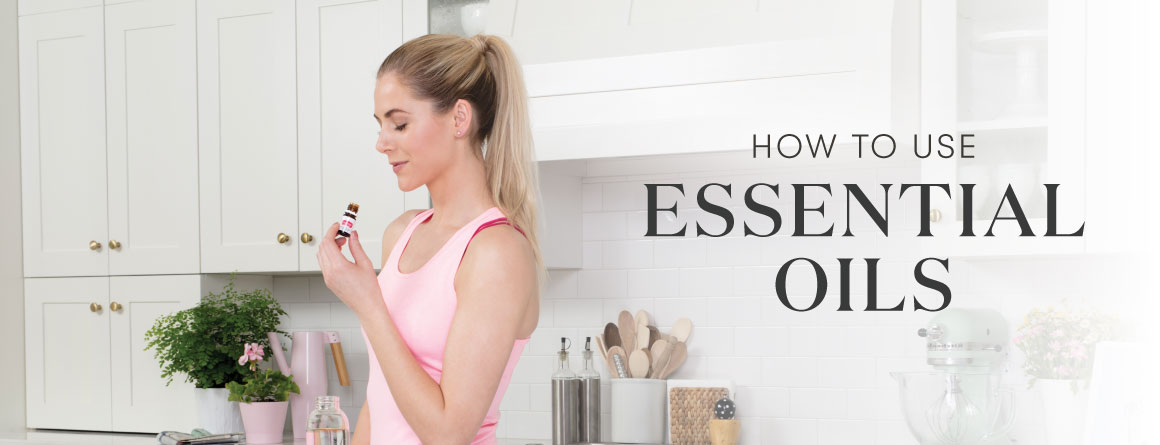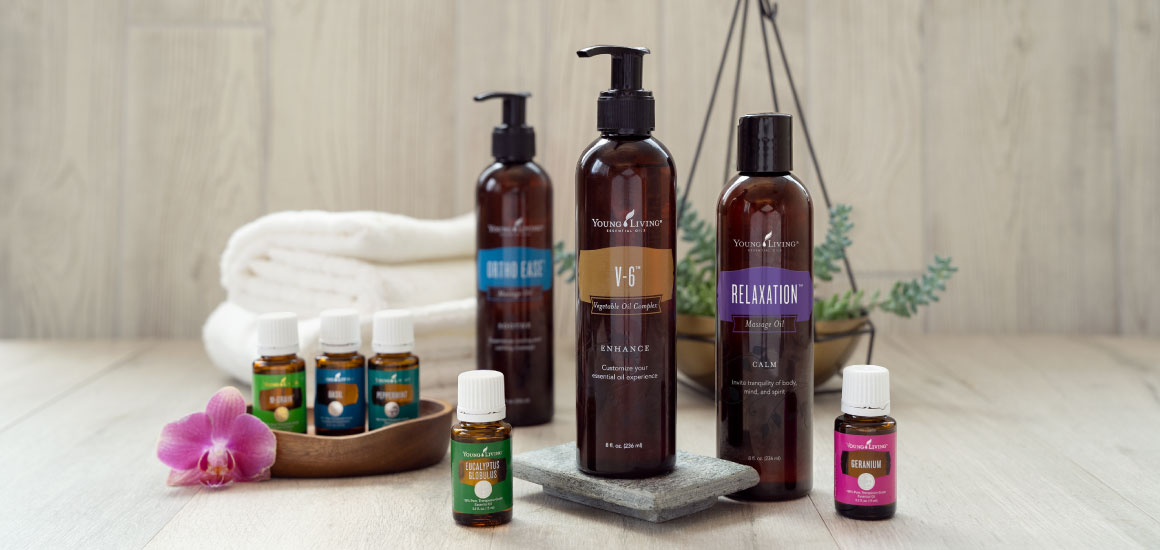How to Use Essential Oils

Maybe you’re unpacking your Premium Starter Kit, you were gifted a bunch of essential oils—you lucky dog—or, like some of us, you dove head-first into essential oils because you knew there was something special about them. Now you’re overwhelmed by how to use the dang things.
Have no fear, friend, we’ve all been intimidated by how to use essential oils, asked our friends for a chart on essential oils uses, and scoured Pinterest for guides on essential oil uses. With a little practice and this simple guide, you’ll be an expert in no time. In fact, you’ll be the friend who gets all the “How do I use this essential oil?” texts!
To master your use of essential oils, you’ll need to understand a few things right off the bat. Typically, oils are used in one of three ways. This essential oils uses list will help you become a pro in no time!
How to use essential oils:
1. Aromatically
2. Topically
3. Internally
How to use essential oils aromatically
The aromatic use of essential oils may be the most familiar. Perhaps you’ve wandered into a spa and been delighted by the aroma of Eucalyptus and Tea Tree oils or maybe felt the soothing calm of Lavender’s scent in one of your favorite at-home products. Now you can learn how to get the benefits of essential oils by diffusing their aroma!
- If you don’t know how to use an essential oil diffuser, check the instructions specific to your product for water and oil ratios. For instance, if you’re using the Young Living Aria
 diffuser, you’ll add 15–25 drops of oil to the water, but if you are using Young Living’s Desert Mist
diffuser, you’ll add 15–25 drops of oil to the water, but if you are using Young Living’s Desert Mist diffuser, use only 8–10 drops. There’s always a bit of math involved, so brush up on your fractions, folks!
diffuser, use only 8–10 drops. There’s always a bit of math involved, so brush up on your fractions, folks! - Try this combination in your diffuser before bedtime to promote rest and relaxation:
- 4 drops Lavender
- 3 drops Cedarwood
- 2 drops Frankincense
- Even without a diffuser, you can enjoy many of the aromatic benefits of essential oils. Add drops of your favorite essential oils to a cotton ball and place it in areas where you want to disperse the scent. You’ll be amazed by how well this simple solution works!
- Freshen a smelly space in minutes by adding a few drops of your favorite citrus oils on a cotton ball, then place it in a gym bag, garbage can, or anywhere else that needs a scent upgrade.
- The easiest way to get the aromatic benefits of an essential oil is by simply taking a few drops from the bottle into the palm of your hands. Cup your hands around your mouth and nose and inhale, breathing deeply for as long as needed—but, you know, take it easy so you don’t hyperventilate or anything.
How to use essential oils topically
The topical use of essential oils is one of the most popular. Once you get the hang of this application, it will probably be one of your favorites! Usually, finding out how to use essential oils on the skin is what turns most people from casual oil users to devotees.
- You can apply essential oils to most parts of your body, but you want to be cautious of your most sensitive skin. To get the most benefit from your essential oils, you’ll find that certain applications are more effective than others.
- Use your head, literally! Essential oils can be applied to the crown of your head, behind the ears, to your neck, and to your temples.
- If the aroma of an oil is too strong, or your skin is sensitive, you can dilute it with a carrier oil. Young Living’s V-6
 Vegetable Oil Complex lets you adjust the strength of the oil according to your preference.
Vegetable Oil Complex lets you adjust the strength of the oil according to your preference. - Essential oils are great for massage! For a calming massage, Lavender and Cedarwood essential oils can be added to a carrier oil. For rejuvenating muscles after a long workout, experience the cooling effect of Peppermint essential oil’s menthol in a sports massage .
- In aromatherapy, many people choose to apply essential oils to the tops and soles of the feet. One common application is using Tea Tree essential oil as part of spa and beauty treatments—especially to help fight odor on particularly funky feet before a pedicure. Just 10–15 drops in a bath of lukewarm water ought to do the trick.

- Essential oils can help improve the appearance of healthy skin! With these tricks in your arsenal, you’ll know how to use essential oils on skin to reduce the appearance of blemishes and to give yourself a healthy glow!
- Another great use for Tea Tree essential oil is reducing the appearance of blemishes. You can use a cotton swab to apply the oil directly to the affected area.
- For smoother-looking skin, you can add Bergamot essential oil to your nighttime routine. Keep in mind that Bergamot and other citrus oils can cause photosensitivity, so you should avoid sun exposure after application.
- For an aromatic treat that can also help give your whole body smoother-looking skin, add Lavender essential oil to your next bath.
How to use essential oils internally
Did you know that you can get the benefits of essential oils by ingesting them? Young Living’s Vitality line was developed to provide a clear distinction between oils for internal use and those for topical and aromatic use. All are the same pure, authentic essential oils, we’ve just labeled them differently so there’s no confusion!
line was developed to provide a clear distinction between oils for internal use and those for topical and aromatic use. All are the same pure, authentic essential oils, we’ve just labeled them differently so there’s no confusion!
- Adding a drop or two of your favorite Vitality oil to water throughout the day is a great way to stay hydrated. Oils like Lemon Vitality, Grapefruit Vitality, and Orange Vitality provide a hint of flavor in a calorie-free replacement for soda or juice. Other flavors like Peppermint Vitality and Thieves Vitality provide a spicy kick throughout your day.
- Adding essential oils to recipes is a great way to get potent and unique flavors into your favorite foods.
- Love homemade ice cream? Add a sophisticated twist with Lavender Vitality
 in our Blueberry-Lavender Ice Cream.
in our Blueberry-Lavender Ice Cream. - To give your pasta sauces authentic Italian flair, a drop of Oregano Vitality and Basil Vitality oil each will give your meals powerful flavor.
- If you love Thai food, try adding Black Pepper, Lemongrass, and Ginger Vitality oils to any soup recipe!
- Love homemade ice cream? Add a sophisticated twist with Lavender Vitality
Essential oil safety
Essential oils are very potent, so you have to be cautious when you use them. Remember, a little goes a long way!
- Less is more! You can always add another drop, so start slow, whether you’re using your oils topically, aromatically, or internally.
- Due to potency, some oils may be irritating to the skin. If irritation occurs, immediately apply V-6 Vegetable Oil Complex or pure vegetable oil to the affected area to dilute.
- Always read label directions for each individual oil before use.
- Do not put essential oils in eyes, ears, nose, or other areas with sensitive skin .
From your first bottle of Lavender essential oil to a seven-oil combination in your diffuser, learning how to use essential oils is a process. We’re happy to help you every step of the way! This essential oil uses guide is only the beginning—if you have more questions, check out our post that hits the things people ask most. Think you’ve got this oil thing down? Try testing your essential oil IQ!
You’ve got the hang of it now! How will you share this information?
Tell us in the comments.
The post How to Use Essential Oils appeared first on Young Living Blog.
